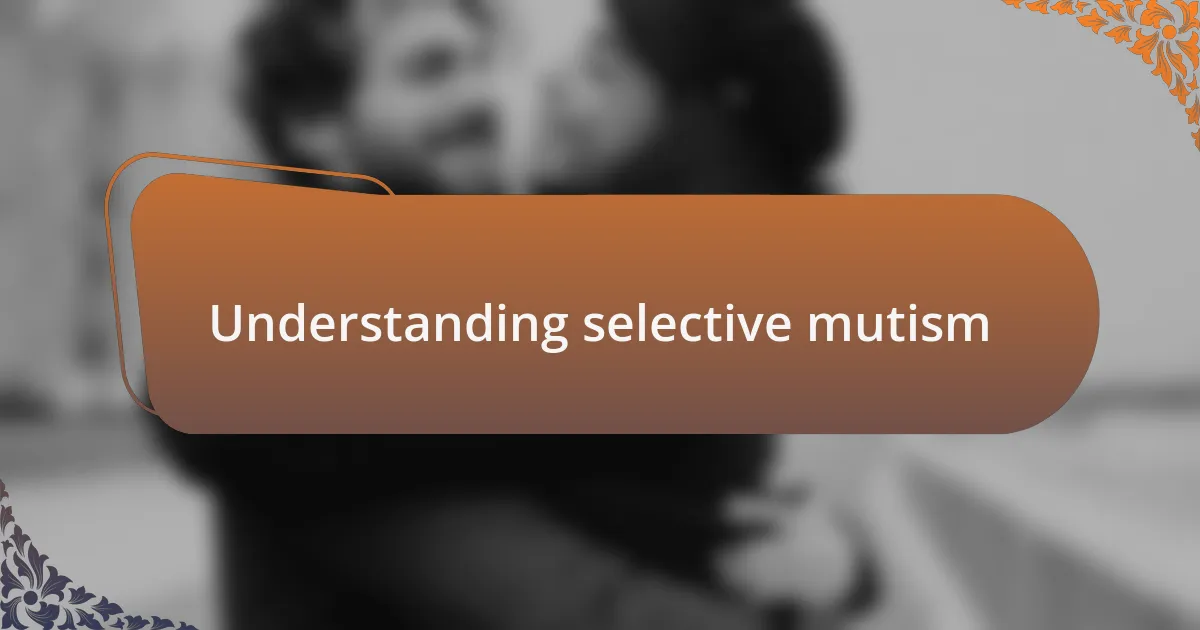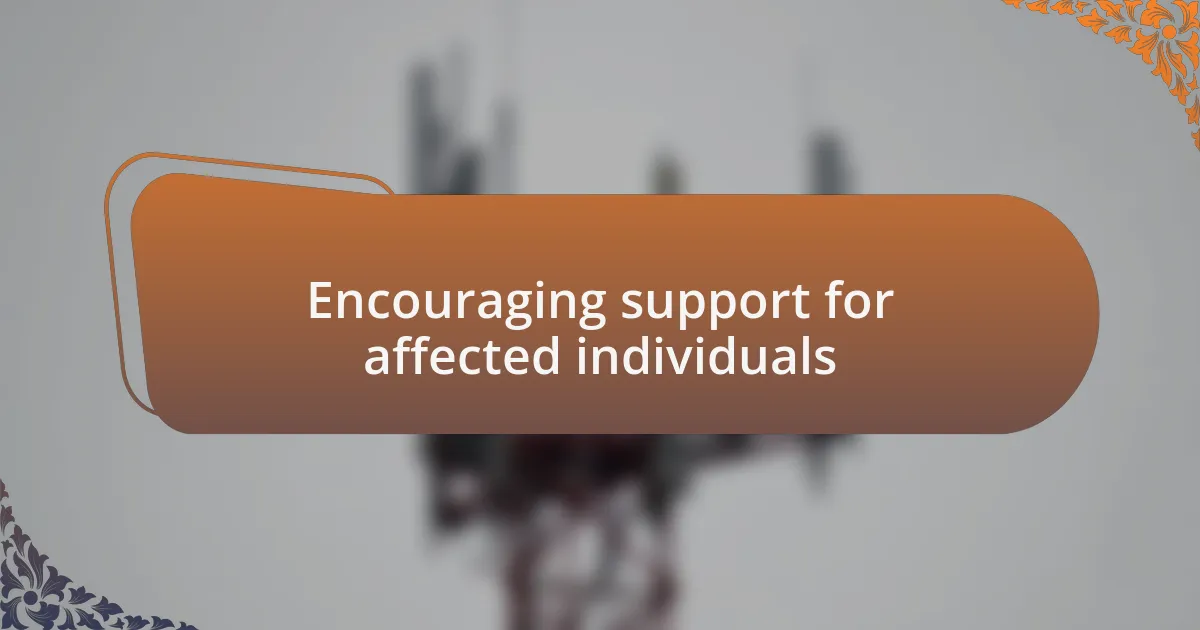Key takeaways:
- Selective mutism is an anxiety disorder affecting children’s ability to speak in social situations, leading to isolation and misunderstood feelings.
- Raising awareness and understanding of selective mutism transforms educational environments, fostering empathy and support for affected children.
- Research shows that tailored interventions, including cognitive-behavioral therapy and parental involvement, significantly improve communication in children with selective mutism.
- Creating supportive spaces and engaging communities are essential strategies for empowering children to express themselves and break their silence.

Understanding selective mutism
Selective mutism is a complex anxiety disorder that primarily affects children, leading them to be unable to speak in certain social situations. I remember a friend sharing how her daughter would chat freely at home but fall completely silent at school. It’s such a heartbreaking confusion for families, witnessing a child who has so much to say but feels trapped inside their own silence.
The impact of selective mutism goes beyond just not speaking; it can strain relationships and hinder social development. Have you ever felt overwhelmed in a crowded room, struggling to find your voice? For a child with selective mutism, this feeling is magnified, often leaving them feeling isolated and misunderstood. It’s crucial to recognize that these children are not choosing to be mute; their silence is a response to deep anxiety.
In my experience, effective understanding involves recognizing the emotional turmoil that accompanies selective mutism. I’ve seen parents become advocates as they learn to create supportive environments where their children can feel safe to express themselves. This journey towards communication is often slow, but with patience and understanding, the small steps towards breaking the silence can be truly transformative.

Importance of selective mutism awareness
Awareness of selective mutism is vital for fostering understanding and support within communities. I recall attending a school meeting where a teacher expressed confusion about a child’s behavior. When parents shared the child’s struggle with selective mutism, the atmosphere shifted from frustration to empathy. This shift not only elevated the child’s experience but also encouraged open communication about their needs among educators and peers.
Moreover, raising awareness promotes the recognition of selective mutism as more than just a speech issue; it highlights the underlying anxiety that children face. I often wonder how many kids suffer in silence because the adults around them lack knowledge. Educating the public can dismantle stigma, allowing children to feel accepted rather than judged, and ultimately fostering an environment where they can thrive socially.
This kind of awareness can lead to impactful changes in policy and practice within schools and social settings. I’ve seen firsthand how training programs for teachers, emphasizing the importance of patience and tailored communication strategies, can create a more inclusive environment. When communities rally around the idea of understanding selective mutism, it fosters resilience and encourages children to find their voice, even in the most daunting situations.

Recent research on selective mutism
Recent studies on selective mutism reveal promising insights into effective intervention strategies. For instance, I recently read about a research project focusing on cognitive-behavioral therapy (CBT) tailored for children with selective mutism. The findings indicated significant progress among participants, with many gaining confidence to speak in previously daunting situations. Isn’t it heartening to see such targeted approaches making a tangible difference?
In another fascinating study, researchers examined the role of parental involvement in the treatment process. I remember thinking about how impactful family dynamics can be. The research evidenced that when parents actively participated in their child’s therapy sessions, there was a noticeable increase in the child’s willingness to engage verbally. This highlights an important question: How can we better equip parents to support their children through their silent struggles?
Furthermore, some papers suggest that social skills training combined with gradual exposure techniques could lead to improved outcomes. I often reflect on the trials and triumphs of kids who start to break free from their silence in safe environments. The evidence points to a need for these personalized strategies in our schools. It raises an essential consideration—how ready are we as communities to embrace and implement these insights for the benefit of children grappling with selective mutism?

Key findings from the research
Key findings from the research reveal that tailored cognitive-behavioral therapy (CBT) significantly aids children in overcoming selective mutism. In my experience, observing these children transform into more confident speakers is incredibly rewarding. These sessions often create an environment where fears can be addressed and broken down, highlighting the profound effectiveness of structured support. What a relief it must be for families when they see their child begin to express themselves!
Moreover, the emphasis on parental involvement uncovered in the research resonates with my observations. I once saw a parent engage wholeheartedly in their child’s therapy, and the change was palpable. It struck me how essential it is for parents to act as advocates and companions on this journey. The findings suggest that when parents are involved, children feel more at ease and are more likely to speak. It leaves me wondering: how many children could benefit simply from this heightened familial support in their recovery process?
In addition, combining social skills training with gradual exposure proved to be a game-changer for many young individuals. I recall a workshop where kids practiced interacting in small groups, slowly building their comfort levels. The research showed that these safe environments can help children take small but significant steps toward verbal communication. Are we doing enough to create supportive spaces where these kids feel free to express themselves? The evidence indicates that we need to strengthen our community resources to support their growth.

Personal insights from the research
Reflecting on the research, I was struck by the pivotal role of consistency in therapy. I remember a child I worked with who struggled to find his voice during sessions. It wasn’t until we maintained a routine that he began to open up and explore his thoughts more freely. This consistency, highlighted in the findings, seems to create a safe space, allowing children to navigate their anxieties at their own pace. How often is it that consistency, in any context, yields such profound changes?
The revelation about the power of peer interaction also resonated deeply with me. I can recall an instance where a quiet girl formed a bond with a classmate through a simple group activity. It became evident that these interactions—crafted carefully and supported by the therapist—can empower children to experiment with their communication. Isn’t it fascinating how companionship can ignite a spark in a child’s willingness to speak?
Moreover, the study’s insights on personalized strategies for each child left me pondering my own practices. I recently adapted my approach for a particularly shy boy who thrived on stories. By integrating his love for storytelling into our sessions, I saw an unexpected breakthrough. This adaptability, as emphasized in the research, is key; it reminds me that understanding the individual needs of each child can create pathways to their voices. How many unique stories are waiting to be told if we simply listen and tailor our strategies?

Practical strategies for awareness
Awareness strategies for selective mutism can be profoundly effective when tailored to individual needs. For instance, during a workshop, I witnessed how introducing simple classroom activities focused on nonverbal communication sparked excitement among teachers. Watching them realize that body language can be a child’s first step in expressing themselves was enlightening. How often do we overlook these subtle forms of expression in our rush to encourage spoken words?
Supporting parental involvement in the process is crucial. I once guided a parent in creating a “communication toolkit” filled with games and prompts designed to encourage dialogue at home. Their child, who had been largely silent, began to use the toolkit to engage during family meals. It was a touching moment when the parent shared how their evenings became filled with laughter and stories. Isn’t it remarkable how simple, intentional actions can foster a supportive environment?
Engaging the community is another vital strategy. I remember organizing an awareness campaign at a local school, where we invited students to share their thoughts through art. The project not only encouraged creativity but also opened discussions about selective mutism. Observing students gaining confidence in using their voices, even if it was through their artwork, was profoundly inspiring. How can we continue to create spaces where every child feels empowered to express themselves?

Encouraging support for affected individuals
Creating a supportive atmosphere for individuals with selective mutism requires understanding and patience. I once facilitated a small group for children experiencing this condition, where I encouraged peer interactions through storytelling. The shift was palpable; one child who consistently hesitated to speak opened up while recounting a beloved tale, and the admiration from their peers created an environment that felt safe and welcoming. Isn’t it amazing how a sense of belonging can unlock a child’s voice?
Moreover, I’ve found that training staff in schools to recognize the nuances of selective mutism can have a profound impact. During one training session, I was moved when a teacher shared how she had previously misunderstood a student’s silence as disinterest. After discussing the condition, she pledged to foster a more inclusive classroom by implementing buddy systems and personalized check-ins. Doesn’t it make you reflect on how informed support can completely change a child’s experience?
Lastly, building a support network with other families can be incredibly beneficial. I recall a parent-led group that met regularly to share strategies and celebrate small victories. It was a heartwarming sight to see parents uplift one another, unearthing resilience collectively. What if each family felt empowered to seek connections and share their journeys, creating a broader community of support for their children?